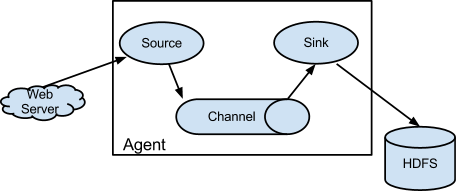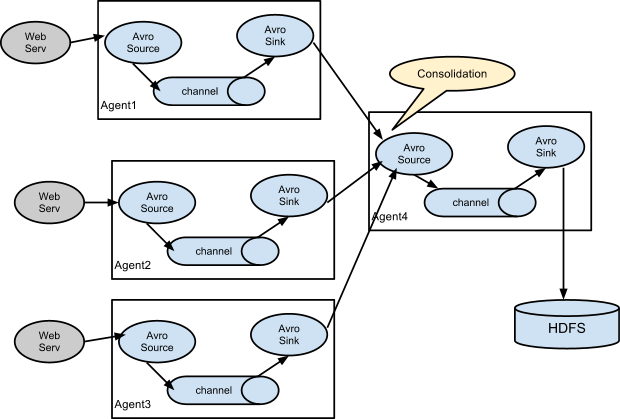Flume數據采集之常見集群配置案例
阿新 • • 發佈:2018-04-07
大數據 Flume [TOC]
非集群配置
這種情況非集群配置方式,比較簡單,可以直接參考我整理的《Flume筆記整理》,其基本結構圖如下:

Flume集群之多個Agent一個source
結構說明
結構圖如下:

說明如下:
即可以把我們的Agent部署在不同的節點上,上面是兩個Agent的情況。其中Agent foo可以部署在日誌產生的節點上, 比如,可以是我們web服務器例如tomcat或者nginx的節點上,foo的source可以配置為監控日誌文件數據的變化, channel則可以基於內存或基於文件進行存儲,而sink即日誌落地可以配置為avro,即輸出到下一個Agent中。 Agent bar可以部署在另一個節點上,當然跟foo在同一個節點也是沒有問題,因為本身Flume是可以多個實例在同一個 節點上運行的。bar主要作用是收集來自不同avro source的節點的日誌數據,實際上,如果我們的web環境是集群的, 那麽web服務器就會有多個節點,這時就有多個web服務器節點產生日誌,我們需要在這多個web服務器上都部署agent, 此時,bar的source就會有多個,後面的案例正是如此,不過在這個小節中,只討論多個agent一個source的情況。 而對於agent bar的數據下沈方式,也是可以選擇多種方式,詳細可以參考官網文檔,這裏選擇sink為HDFS。 不過需要註意的是,在agent foo中,source只有一個,在後面的案例中,會配置多個source,即在這一個agent中, 可以采集不同的日誌文件,後面要討論的多個source,指的是多個不同日誌文件的來源,即foo中的多個source,例如 data-access.log、data-ugctail.log、data-ugchead.log等等。
配置案例
環境說明
如下:

即這裏有兩個節點:
uplooking01: 其中的日誌文件 /home/uplooking/data/data-clean/data-access.log 為web服務器生成的用戶訪問日誌,並且每天會產生一個新的日誌文件。 在這個節點上,我們需要部署一個Flume的Agent,其source為該日誌文件,sink為avro。 uplooking03: 這個節點的作用主要是收集來自不同Flume Agent的日誌輸出數據,例如上面的agent,然後輸出到HDFS中。 說明:在我的環境中,有uplooking01 uplooking02 uplooking03三個節點,並且三個節點配置了Hadoop集群。
配置
- uplooking01
######################################################### ## ##主要作用是監聽文件中的新增數據,采集到數據之後,輸出到avro ## 註意:Flume agent的運行,主要就是配置source channel sink ## 下面的a1就是agent的代號,source叫r1 channel叫c1 sink叫k1 ######################################################### a1.sources = r1 a1.sinks = k1 a1.channels = c1 #對於source的配置描述 監聽文件中的新增數據 exec a1.sources.r1.type = exec a1.sources.r1.command = tail -F /home/uplooking/data/data-clean/data-access.log #對於sink的配置描述 使用avro日誌做數據的消費 a1.sinks.k1.type = avro a1.sinks.k1.hostname = uplooking03 a1.sinks.k1.port = 44444 #對於channel的配置描述 使用文件做數據的臨時緩存 這種的安全性要高 a1.channels.c1.type = file a1.channels.c1.checkpointDir = /home/uplooking/data/flume/checkpoint a1.channels.c1.dataDirs = /home/uplooking/data/flume/data #通過channel c1將source r1和sink k1關聯起來 a1.sources.r1.channels = c1 a1.sinks.k1.channel = c1
- uplooking03
#########################################################
##
##主要作用是監聽avro,采集到數據之後,輸出到hdfs
## 註意:Flume agent的運行,主要就是配置source channel sink
## 下面的a1就是agent的代號,source叫r1 channel叫c1 sink叫k1
#########################################################
a1.sources = r1
a1.sinks = k1
a1.channels = c1
#對於source的配置描述 監聽avro
a1.sources.r1.type = avro
a1.sources.r1.bind = 0.0.0.0
a1.sources.r1.port = 44444
#對於sink的配置描述 使用log日誌做數據的消費
a1.sinks.k1.type = hdfs
a1.sinks.k1.hdfs.path = /input/data-clean/access/%y/%m/%d
a1.sinks.k1.hdfs.filePrefix = flume
a1.sinks.k1.hdfs.fileSuffix = .log
a1.sinks.k1.hdfs.inUsePrefix = tmpFlume
a1.sinks.k1.hdfs.inUseSuffix = .tmp
a1.sinks.k1.hdfs.useLocalTimeStamp = true
a1.sinks.k1.hdfs.round = true
a1.sinks.k1.hdfs.roundValue = 10
a1.sinks.k1.hdfs.roundUnit = second
#配置下面兩項後,保存到HDFS中的數據才是文本
#否則通過hdfs dfs -text查看時,顯示的是經過壓縮的16進制
a1.sinks.k1.hdfs.serializer = TEXT
a1.sinks.k1.hdfs.fileType = DataStream
#對於channel的配置描述 使用內存緩沖區域做數據的臨時緩存
a1.channels.c1.type = memory
a1.channels.c1.capacity = 1000
a1.channels.c1.transactionCapacity = 100
#通過channel c1將source r1和sink k1關聯起來
a1.sources.r1.channels = c1
a1.sinks.k1.channel = c1測試
首先要確保會有日誌生成,其輸出為/home/uplooking/data/data-clean/data-access.log。
在uplooking03上啟動Flume Agent:
[uplooking@uplooking03 flume]$ flume-ng agent -n a1 -c conf --conf-file conf/flume-source-avro.conf -Dflume.root.logger=INFO,console在uplooking01上啟動Flume Agent:
flume-ng agent -n a1 -c conf --conf-file conf/flume-sink-avro.conf -Dflume.root.logger=INFO,console一段時間後,便可以在hdfs中看到寫入的日誌文件:
[uplooking@uplooking02 ~]$ hdfs dfs -ls /input/data-clean/access/18/04/07
18/04/07 08:52:02 WARN util.NativeCodeLoader: Unable to load native-hadoop library for your platform... using builtin-java classes where applicable
Found 26 items
-rw-r--r-- 3 uplooking supergroup 1131 2018-04-07 08:50 /input/data-clean/access/18/04/07/flume.1523062248369.log
-rw-r--r-- 3 uplooking supergroup 1183 2018-04-07 08:50 /input/data-clean/access/18/04/07/flume.1523062248370.log
-rw-r--r-- 3 uplooking supergroup 1176 2018-04-07 08:50 /input/data-clean/access/18/04/07/flume.1523062248371.log
......查看文件中的數據:
[uplooking@uplooking02 ~]$ hdfs dfs -text /input/data-clean/access/18/04/07/flume.1523062248369.log
18/04/07 08:55:07 WARN util.NativeCodeLoader: Unable to load native-hadoop library for your platform... using builtin-java classes where applicable
1000 220.194.55.244 null 40604 0 POST /check/init HTTP/1.1 500 null Mozilla/5.0 (Windows NT 6.1; WOW64) AppleWebKit/537.36 (KHTML, like Gecko) Chrome/59.0.3071.115 Safari/537.3 1523062236368
1002 221.8.9.6 80 886a1533-38ca-466c-86e1-0b84022f781b 20201 1 GET /top HTTP/1.0 500 null Mozilla/5.0 (Windows NT 6.1; WOW64) AppleWebKit/537.36 (KHTML, like Gecko) Chrome/59.0.3071.115 Safari/537.3 1523062236869
1002 61.172.249.96 99fb19c4-ec59-4abd-899c-4059dea39ead 0 0 POST /updateById?id=21 HTTP/1.1 408 null Mozilla/5.0 (Windows NT 6.1; WOW64; Trident/7.0; rv:11.0) like Gecko 1523062237370
1003 61.172.249.96 886a1533-38ca-466c-86e1-0b84022f781b 10022 1 GET /tologin HTTP/1.1 null /update/pass Mozilla/5.0 (Windows; U; Windows NT 5.1)Gecko/20070309 Firefox/2.0.0.3 1523062237871
1003 125.39.129.67 6839fff8-7b3a-48f5-90cd-0f45c7be1aeb 10022 1 GET /tologin HTTP/1.0 408 null Mozilla/5.0 (Windows; U; Windows NT 5.1)Gecko/20070309 Firefox/2.0.0.3 1523062238372
1000 61.172.249.96 89019ae0-6140-4e5a-9061-e3af74f3e4a8 10022 1 POST /stat HTTP/1.1 null /passpword/getById?id=11 Mozilla/4.0 (compatible; MSIE 5.0; WindowsNT) 1523062238873如果在uplooking03的Flume agent不配置hdfs.serializer=TEXT和hdfs.fileType=DataStream,那麽上面查看到的數據會是16進制數據。
Flume集群之多個Agent多個source
結構說明
如下:

配置案例
環境說明
在我們的環境中,如下:
即在我們的環境中,日誌源有三份,分別是data-access.log、data-ugchead.log、data-ugctail.log
不過在下面的實際配置中,日誌源的agent我們只使用兩個,uplooking01和uplooking02,它們的sink都
輸出到uplooking03的source中。配置
uplooking01和uplooking02的配置都是一樣的,如下:
#########################################################
##
##主要作用是監聽文件中的新增數據,采集到數據之後,打印在控制臺
## 註意:Flume agent的運行,主要就是配置source channel sink
## 下面的a1就是agent的代號,source叫r1 channel叫c1 sink叫k1
#########################################################
a1.sources = r1 r2 r3
a1.sinks = k1
a1.channels = c1
#對於source r1的配置描述 監聽文件中的新增數據 exec
a1.sources.r1.type = exec
a1.sources.r1.command = tail -F /home/uplooking/data/data-clean/data-access.log
a1.sources.r1.interceptors = i1 i2
a1.sources.r1.interceptors.i1.type = static
##靜態的在header中添加一個key value,下面就配置了兩個攔截器,i1和i2
a1.sources.r1.interceptors.i1.key = type
a1.sources.r1.interceptors.i1.value = access
a1.sources.r1.interceptors.i2.type = timestamp
## timestamp的作用:這裏配置了的話,在負責集中收集日誌的flume agent就不需要配置
## a1.sinks.k1.hdfs.useLocalTimeStamp = true也能通過這些%y/%m/%d獲取時間信息
## 這樣一來的話,就可以減輕集中收集日誌的flume agent的負擔,因為此時的時間信息可以直接從source中獲取
#對於source r2的配置描述 監聽文件中的新增數據 exec
a1.sources.r2.type = exec
a1.sources.r2.command = tail -F /home/uplooking/data/data-clean/data-ugchead.log
a1.sources.r2.interceptors = i1 i2
a1.sources.r2.interceptors.i1.type = static
##靜態的在header中添加一個key value,下面就配置了兩個攔截器,i1和i2
a1.sources.r2.interceptors.i1.key = type
a1.sources.r2.interceptors.i1.value = ugchead
a1.sources.r2.interceptors.i2.type = timestamp
#對於source r3的配置描述 監聽文件中的新增數據 exec
a1.sources.r3.type = exec
a1.sources.r3.command = tail -F /home/uplooking/data/data-clean/data-ugctail.log
a1.sources.r3.interceptors = i1 i2
a1.sources.r3.interceptors.i1.type = static
##靜態的在header中添加一個key value,下面就配置了兩個攔截器,i1和i2
a1.sources.r3.interceptors.i1.key = type
a1.sources.r3.interceptors.i1.value = ugctail
a1.sources.r3.interceptors.i2.type = timestamp
#對於sink的配置描述 使用avro日誌做數據的消費
a1.sinks.k1.type = avro
a1.sinks.k1.hostname = uplooking03
a1.sinks.k1.port = 44444
#對於channel的配置描述 使用文件做數據的臨時緩存 這種的安全性要高
a1.channels.c1.type = file
a1.channels.c1.checkpointDir = /home/uplooking/data/flume/checkpoint
a1.channels.c1.dataDirs = /home/uplooking/data/flume/data
#通過channel c1將source r1 r2 r3和sink k1關聯起來
a1.sources.r1.channels = c1
a1.sources.r2.channels = c1
a1.sources.r3.channels = c1
a1.sinks.k1.channel = c1uplooking03的配置如下:
#########################################################
##
##主要作用是監聽avro,采集到數據之後,輸出到hdfs
## 註意:Flume agent的運行,主要就是配置source channel sink
## 下面的a1就是agent的代號,source叫r1 channel叫c1 sink叫k1
#########################################################
a1.sources = r1
a1.sinks = k1
a1.channels = c1
#對於source的配置描述 監聽avro
a1.sources.r1.type = avro
a1.sources.r1.bind = 0.0.0.0
a1.sources.r1.port = 44444
#對於sink的配置描述 使用log日誌做數據的消費
a1.sinks.k1.type = hdfs
a1.sinks.k1.hdfs.path = /input/data-clean/%{type}/%Y/%m/%d
a1.sinks.k1.hdfs.filePrefix = %{type}
a1.sinks.k1.hdfs.fileSuffix = .log
a1.sinks.k1.hdfs.inUseSuffix = .tmp
a1.sinks.k1.hdfs.round = true
a1.sinks.k1.hdfs.rollInterval = 0
a1.sinks.k1.hdfs.rollCount = 0
a1.sinks.k1.hdfs.rollSize = 10485760
# 如果希望上面配置的日誌文件滾動策略生效,則必須要配置下面這一項
a1.sinks.k1.hdfs.minBlockReplicas = 1
#配置下面兩項後,保存到HDFS中的數據才是文本
#否則通過hdfs dfs -text查看時,顯示的是經過壓縮的16進制
a1.sinks.k1.hdfs.serializer = TEXT
a1.sinks.k1.hdfs.fileType = DataStream
#對於channel的配置描述 使用內存緩沖區域做數據的臨時緩存
a1.channels.c1.type = memory
a1.channels.c1.capacity = 1000
a1.channels.c1.transactionCapacity = 100
#通過channel c1將source r1和sink k1關聯起來
a1.sources.r1.channels = c1
a1.sinks.k1.channel = c1測試
首先需要保證uplooking01和uplooking02上都能正常地產生日誌。
在uplooking03上啟動Agent:
[uplooking@uplooking03 flume]$ flume-ng agent -n a1 -c conf --conf-file conf/flume-source-avro.conf -Dflume.root.logger=INFO,console分別在uplooking01和uplooking02上啟動Agent:
flume-ng agent -n a1 -c conf --conf-file conf/flume-sink-avro.conf -Dflume.root.logger=INFO,console一段時間後,可以在HDFS中查看相應的日誌文件:
$ hdfs dfs -ls /input/data-clean
18/04/08 01:34:36 WARN util.NativeCodeLoader: Unable to load native-hadoop library for your platform... using builtin-java classes where applicable
Found 3 items
drwxr-xr-x - uplooking supergroup 0 2018-04-07 22:00 /input/data-clean/access
drwxr-xr-x - uplooking supergroup 0 2018-04-07 22:00 /input/data-clean/ugchead
drwxr-xr-x - uplooking supergroup 0 2018-04-07 22:00 /input/data-clean/ugctail查看某個日誌目錄下的日誌文件:
[uplooking@uplooking02 data-clean]$ hdfs dfs -ls /input/data-clean/access/2018/04/07
18/04/08 01:35:27 WARN util.NativeCodeLoader: Unable to load native-hadoop library for your platform... using builtin-java classes where applicable
Found 2 items
-rw-r--r-- 3 uplooking supergroup 2447752 2018-04-08 01:02 /input/data-clean/access/2018/04/08/access.1523116801502.log
-rw-r--r-- 3 uplooking supergroup 5804 2018-04-08 01:02 /input/data-clean/access/2018/04/08/access.1523120538070.log.tmp可以看到日誌文件數量非常少,那是因為前面在配置uplooking03的agent時,日誌文件滾動的方式為,單個文件滿10M再進行切分日誌文件。
Flume數據采集之常見集群配置案例
